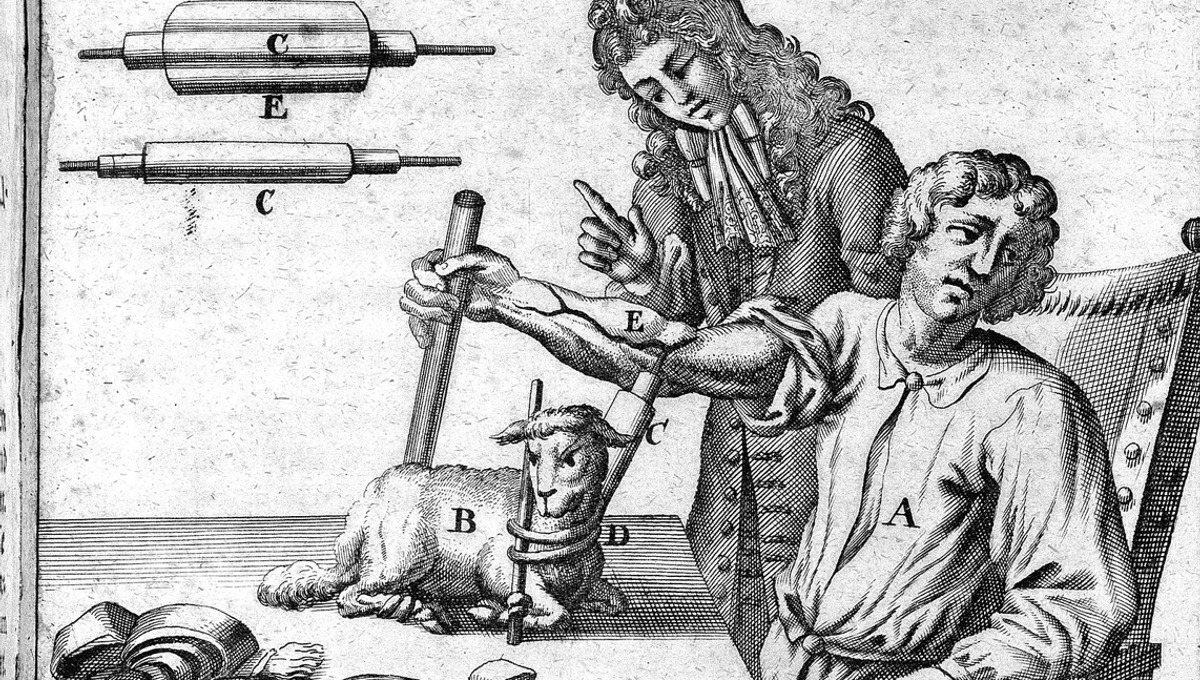
Xenotransplantation, the transplantation of non-human body parts into humans, has recently come blazing to the forefront of biomedical science. In the past two years, this once-obscure field of surgery has reached several important milestones, including the transplantation of genetically engineered pig hearts and kidneys into brain-dead patients.
As groundbreaking as these feats may be, xenotransplantation has a curiously long history – with plenty of ethically dubious misfires.
Some of the first vaguely scientific attempts started in the 17th century with the work of French physician Jean-Baptiste Denys who was an early pioneer of blood transfusions. In the first documented attempt at blood transfusion, Denys pumped the blood of a sheep into a 15-year-old boy who was suffering from chronic fever. As per Denys’ accounts, he had a “startling” recovery and quickly regained “a clear and happy countenance”. His long-term recovery remains a mystery.
Unsurprisingly, however, not all of these experiments were a success. Xenotransfusions became outlawed in France around 1670 after the death of one of Denys’ patients.
Centuries later, scientists started to dabble with the cross-species grafts of tissues and organs, not just blood. One plucky pioneer of this crude precursor to xenotransplantation was Serge Voronoff, a Russian scientist working in Paris during the early 20th century.
His “pièce de résistance” was transplanting slices of chimpanzee testicles into the balls of older men who had lost their “zest for life”. He reportedly performed a “significant number” of these surgeries and earned a fortune doing so, despite it being total bollocks, so to speak.
One recipient of Voronoff’s work was Australian pharmacist Dr Henry Leighton-Jones, better known as “Monkey Jones”, who received an ape testicle graft in Paris in 1929. Happy with the results, he returned home to Australia and continued Voronoff’s legacy by carrying out numerous similar surgeries himself.
By the 1960s, the idea of using non-human primates as transplant donors caught the imagination of Dr Keith Reemtsma, a US scientist who spent much of his career at Tulane University in Louisiana. While kidney transplants had been developed around this time, the number of transplantations was extremely limited due to the lack of availability of kidneys from deceased humans.
To address the problem, Reemtsma explored using kidneys from our closest living relatives, the chimpanzee. Between 1963 and 1964, at least 13 human patients received a double kidney transplant from organs sourced from chimpanzees.
Most of these transplantations failed due to rejection or infections, causing the patients to die within eight weeks. Remarkably though, a few instances had limited success. One of Reemtsma’s patients lived for nine months and even managed to return to work as a schoolteacher, appearing to be in good health.
One day, however, she suddenly collapsed and died. The chimp kidney appeared to be healthy and no rejection had occurred, leading doctors to conclude she simply died of an acute electrolyte disturbance.
There have even been numerous bids to transplant primate hearts into humans. One of the most famous attempts was carried out by Dr Leonard Bailey who transplanted a baboon heart into an infant girl, known as Baby Fae, in 1984.
The baby girl had been born prematurely and was suffering from hypoplastic left heart syndrome, a critical defect that requires urgent surgery. With no infant donor hearts available, Bailey pieced together a last-ditch plan: he went down to the hospital’s research lab and removed the heart of an anesthetized baboon. He returned upstairs and implanted it into the girl’s chest.
At first, it appeared to have worked, as the walnut-sized heart started to beat. However, Baby Fae died 20 days later due to acute rejection.
The case became highly publicized and garnered more than a fair amount of controversy in the media. If one good thing did come of the operation, it raised awareness of the pressing need for more human organs available for infants in need of a transplant.
Even today, xenotransplantation can raise eyebrows among the public and bioethicists are still grappling with the moral considerations associated with the practice. However, it’s worth highlighting that these historical examples of cross-species transplantation are miles away from the xenotransplants of the 2020s, which have benefited from decades of wider advances in transplant surgery and biomedical science.
Whatever your stance on the issue, it’s a fact that there is a desperate shortage of organ donors that is literally killing hundreds of people each year. While there’s still much work to be done, xenotransplantation has the potential to solve this problem and save lives.
Source Link: The Strange And Shocking History Of Cross-Species Organ Transplants